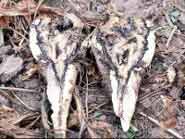|
Although bacterial disease on sugar beet is common, most of the bacteria
cause little damage. The exception to the rule is the destructive bacteria Erwinia
carotovora subspecies betavasculorum, the causal agent of bacterial vascular
necrosis and rot. The disease is most prevalent and destructive in the warmer parts of
California, Washington, Idaho and Texas.
The causal agent of the disease is a bacteria named Erwinia
carotovora subspecies betavasculorum. The bacteria is single celled, rod-shaped
and gram-negative. Isolated colonies of the bacteria are white with a yellow to orange
center and undulating to coralloid margins, resembling a fried egg (see Image #5).
 Image #5
(click image for full page view) Image #5
(click image for full page view)
The primary host is the sugar beet. It can overwinter on unharvested
beets, and can be detected in soil up to two months after harvest. It has also been
isolated on weeds. It is thought that the disease is spread by infected soil deposited in
plant crowns by farm machinery, splashing water and insects. Injury to the crown,
petioles, crowns is necessary for infection.
4. Disease Control
The most effective way to control Erwinia is by using resistant seed
varieties. Cultivation practices that produce injury to the beets should not be used. The
optimal distance to plant stands is spacing beets 6-8 inches apart, which should reduce
losses in susceptible cultivars. Other factors can decrease disease levels are judicious
nitrogen fertilization, early planting.
|





